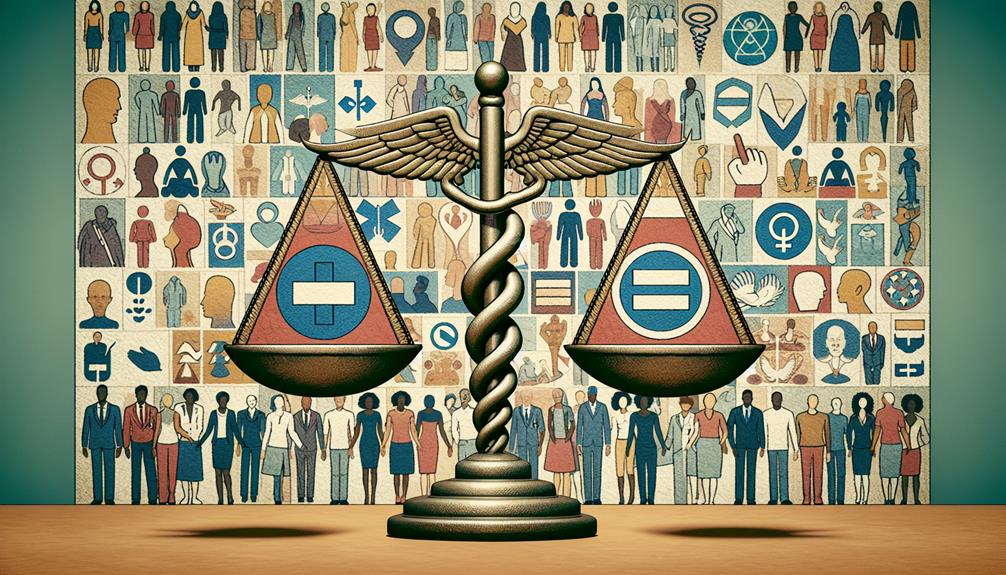Did you know that nearly half of the countries worldwide still have laws that restrict women’s ability to access healthcare? This stark statistic highlights the importance of CEDAW Article 12, which uniquely focuses on women’s rights to health, particularly reproductive health. Unlike broader human rights articles that advocate for general medical access and nondiscrimination, Article 12 specifically mandates equal health service access for women and targets gender-based health disparities. Now, consider how this specialization impacts global health policies and the ongoing struggle for gender equality in healthcare. What challenges might arise from these targeted protections, and how do they interact with other rights?
CEDAW Article 12
You’ll find that CEDAW Article 12 distinctly emphasizes women’s rights to health care, particularly in the domains of reproductive health. It mandates state parties to guarantee access to services, including family planning and prenatal care, under conditions of equality with men.
This provision is vital as it addresses both the prevention and the treatment of reproductive health issues, setting a standard for gender-specific healthcare rights.
Overview of CEDAW
As you examine the Convention on the Elimination of All Forms of Discrimination Against Women (CEDAW), it’s important to recognize its historical context and significance.
Established in 1979 by the UN General Assembly, CEDAW serves as a landmark international treaty aiming to eradicate discrimination against women and promote equality.
Article 12 specifically addresses women’s rights to health, emphasizing the need for gender-sensitive healthcare policies and practices.
Brief history and significance of CEDAW
The Convention on the Elimination of All Forms of Discrimination Against Women (CEDAW), adopted in 1979 by the United Nations General Assembly, marks a pivotal advancement in global women’s rights.
- Legal Framework: Establishes an international legal standard for women’s rights.
- Accountability: Mandates state parties to eliminate discrimination.
- Monitoring: Involves regular reviews by a dedicated committee.
- Advocacy Tool: Empowers women’s groups globally.
- Comprehensive Coverage: Addresses civil, political, economic, social, and cultural rights.
Key Provisions of CEDAW Article 12
You’ll find that CEDAW Article 12 specifically mandates equality in access to healthcare services. This provision guarantees that women are entitled to the same quality and standard of medical care as men, addressing both preventative and therapeutic measures.
It’s important to understand how this equality isn’t just aspirational but legally enforceable under international law.
Equality in access to healthcare services
CEDAW Article 12 mandates equal access to healthcare services for women, ensuring non-discrimination in medical treatment and care.
- Preventive Care: Emphasizes the importance of preventive measures, including screenings and vaccinations.
- Reproductive Rights: Guarantees rights to safe maternity and contraception choices.
- Education: Advocates for health education to empower women.
- Legal Recourse: Provides avenues for addressing grievances related to healthcare discrimination.
- Cultural Sensitivity: Encourages respect for cultural differences in healthcare provision.
Reproductive rights and healthcare
When analyzing CEDAW Article 12, it’s crucial to acknowledge its pivotal role in mandating the elimination of discrimination within healthcare settings.
This specific provision guarantees that women’s reproductive rights and health are safeguarded under the law, free from bias or neglect.
It sets a global standard, compelling member states to commit to practical changes in their health policies and practices, enhancing women’s health rights and access.
Elimination of discrimination in healthcare settings
Eliminating discrimination in healthcare settings is a core focus of Article 12 under the Convention on the Elimination of All Forms of Discrimination Against Women.
Equal Access: Ensuring women’s equal access to healthcare services.
Education on Rights: Promoting awareness among women of their health rights.
Legal Frameworks: Developing stronger legal protections against healthcare discrimination.
Cultural Competence: Training providers in gender-sensitive care.
Monitoring Mechanisms: Implementing systems to monitor and address disparities.
Comparing Article 12 with Other Human Rights Articles
As you explore the human rights framework, it’s important to identify the unique aspects of CEDAW Article 12, particularly in its approach to women’s health rights. This article stands out by explicitly addressing healthcare disparities through an intersectional lens, which isn’t as prominently featured in other human rights articles.
Understanding these distinctions helps in appreciating the thorough efforts CEDAW makes towards gender equality in health care.
Overview of Human Rights Framework
You’ll find that CEDAW Article 12 differs notably from other human rights treaties in its specific focus on women’s health rights.
While examining these distinctions, remember that each treaty addresses unique aspects of human rights, offering a tailored approach to specific issues.
Comparing them highlights how Article 12 uniquely advances gender-specific health concerns within the broader human rights landscape.
major human rights treaties
To understand the context of CEDAW Article 12, it’s crucial to compare it with other articles within major human rights treaties. Here’s a breakdown of key treaties you should consider:
- Universal Declaration of Human Rights (UDHR)
- International Covenant on Civil and Political Rights (ICCPR)
- International Covenant on Economic, Social and Cultural Rights (ICESCR)
- Convention Against Torture (CAT)
- Convention on the Rights of the Child (CRC)
Distinguishing Features of CEDAW Article 12
You’ll find that CEDAW Article 12 uniquely prioritizes women’s health and well-being, setting it apart from other human rights articles.
This focus underscores the necessity of addressing gender-specific health issues through legal frameworks.
Unlike broader human rights provisions, Article 12 provides explicit directives for states to eliminate discrimination against women in healthcare.
Focus on women’s health and well-being
In contrast to other human rights articles, CEDAW Article 12 specifically mandates nations to guarantee the health and well-being of women, highlighting its unique focus on gender-specific health issues.
- Maternal Health: Guarantees access to maternity services.
- Reproductive Rights: Protects reproductive choices.
- Gender-Based Violence: Addresses health impacts of violence.
- Mental Health: Recognizes the psychological aspect.
- Preventive Care: Advocates for regular screenings and health education.
Intersectionality in addressing healthcare disparities
Article 12 of CEDAW specifically targets the intersectionality of gender and health, setting it apart from other human rights articles that may not address these overlapping disparities with the same importance. As you explore the nuances of this provision, you’ll recognize that it explicitly mandates states to eliminate discrimination against women in healthcare, guaranteeing equitable access to medical services, including those related to family planning.
Unlike broader human rights instruments, which often tackle discrimination or health in more specific terms, Article 12 focuses on the unique nexus where gender intersects with health outcomes. This concentration acknowledges that women’s health issues aren’t just biological or medical in nature, but are also profoundly influenced by social, economic, and cultural factors. This intersectional approach is significant because it compels you to ponder how multiple forms of inequality compound and influence women’s health rights and access to healthcare services.
Moreover, by comparing Article 12 to other articles, such as those found in the Universal Declaration of Human Rights, you’ll see that while general health rights are affirmed, the specific challenges faced by women due to their gender are often overlooked. CEDAW fills this gap by providing a targeted framework that addresses and highlights the importance of a nuanced understanding of health disparities through the lens of gender. This ensures a more detailed approach to human rights, where you’re not just aware of the issues but are also equipped to actively address them.
Challenges and Criticisms of CEDAW Article 12
As you examine CEDAW Article 12, you’ll find that its implementation often faces significant hurdles, primarily due to varying national legal frameworks and cultural norms.
Critics also argue that its gender-neutral language fails to address the specific needs and issues faced by women, potentially diluting its impact.
These factors contribute to the ongoing debate about the effectiveness of this human rights tool in promoting gender equality.
Implementation Challenges
You’ll find that a significant challenge in implementing CEDAW Article 12 is the lack of robust enforcement mechanisms.
Without stringent, enforceable protocols, the commitment to eliminate discrimination against women in health care remains largely theoretical.
This gap not only undermines the effectiveness of the Article but also diminishes the potential progress in women’s health rights globally.
Lack of enforcement mechanisms
One significant challenge in implementing CEDAW Article 12 is its lack of robust enforcement mechanisms, limiting its effectiveness in guaranteeing women’s health rights.
- No compulsory jurisdiction: States aren’t obligated to comply with decisions.
- Limited sanctions: Few consequences for non-compliance.
- Reliance on state reports: Often lacks objective oversight.
- Inadequate local awareness: Enforcement requires local understanding.
- Dependence on political will: Effectiveness hinges on government commitment.
Critiques on Gender-Neutral Language
You may find that the use of gender-neutral language in CEDAW Article 12 raises significant questions about inclusivity in healthcare rights. Critics argue that while it aims to be inclusive, it sometimes fails to address specific women’s health issues directly and thoroughly.
This approach can inadvertently obscure the unique challenges faced by women, reducing the effectiveness of policy interventions designed to target these issues.
Debate on the inclusivity of gender-neutral language in healthcare rights
How effectively does gender-neutral language in CEDAW Article 12 address the specific healthcare needs of all genders?
You must consider whether its broad wording adequately captures the unique health issues facing different genders, or if it inadvertently glosses over them.
- Lack of Specificity: May fail to address unique health challenges.
- Potential Oversights: Vulnerable groups might be neglected.
- Ambiguity: Leads to varied interpretations.
- Implementation Challenges: Difficulties in policy application.
- Advocacy Limitations: Complicates targeted advocacy efforts.
Future Implications and Recommendations
As you consider the future of CEDAW Article 12, it’s important to recognize the potential of enhancing monitoring and reporting mechanisms.
You’ll find that strengthening these aspects can greatly amplify the effectiveness of the article in protecting women’s health rights.
Additionally, precise policy recommendations tailored to bolster Article 12 must be prioritized to guarantee thorough implementation and adherence.
Enhancing Monitoring and Reporting Mechanisms
You must recognize the pivotal role that enhanced data collection and analysis play in strengthening the monitoring and reporting mechanisms under CEDAW Article 12.
Accurate and thorough data allow for targeted interventions and informed policy-making that can more effectively uphold women’s health rights.
Hence, investing in robust data infrastructure and analytical capabilities is essential for the progressive realization of these rights.
Importance of data collection and analysis
Effective data collection and analysis greatly improve the monitoring and reporting mechanisms essential for evaluating the implementation of CEDAW Article 12.
- Identify disparities: Pinpoint areas lacking progress.
- Measure effectiveness: Gauge the impact of interventions.
- Enhance transparency: Provide clear, accessible data.
- Support policy making: Inform decisions with empirical evidence.
- Track changes over time: Observe trends to adjust strategies accordingly.
Policy Recommendations for Strengthening Article 12
To effectively strengthen Article 12 of CEDAW, you must prioritize the promotion of gender-sensitive healthcare policies.
These policies should guarantee equitable access to healthcare services and address the specific needs of women and girls.
Promoting gender-sensitive healthcare policies
Strengthening Article 12 necessitates the development of gender-sensitive healthcare policies that directly address the unique health needs of women.
- Incorporate thorough reproductive health education
- Guarantee access to maternal health services
- Address gender-specific mental health issues
- Eliminate discrimination in healthcare settings
- Promote research on women’s health disparities
These strategies will establish a robust, equitable healthcare framework under Article 12.




